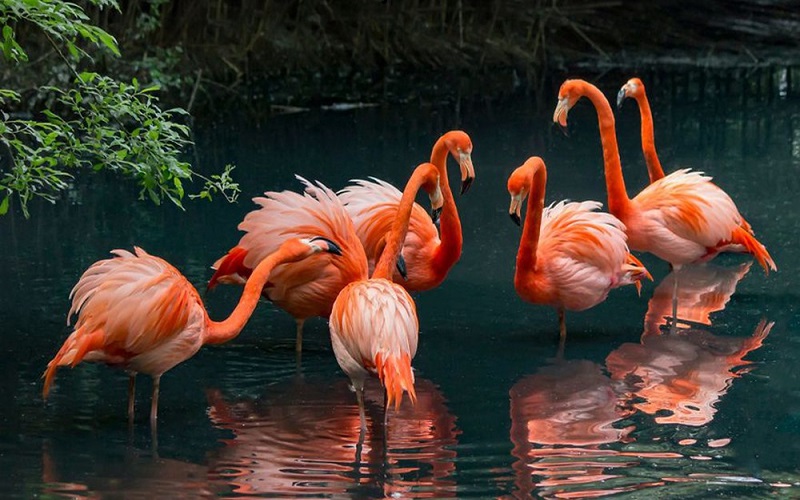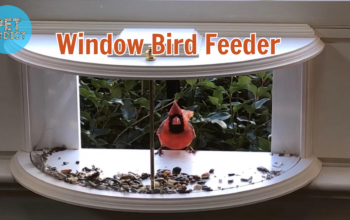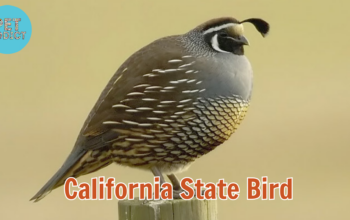TOP 12 Fun Facts About Flamingos 2021: Flamingos are wading birds in the family Phoenicopteridae, order Phoenicopteriformes. Many people love flamingos because of their unique appearance. They are one of the few animals in the wild that adhere to a rather special rule of one-on-one life. They live together, fly together, stand side by side, and die together. Let’s learn about this special bird with Pet addict.
PetAddict.net – The best place where you can find everything about your pet!
Where Do Flamingos Live?
It lives in both the Western Hemisphere and the Eastern Hemisphere, but more in the Western Hemisphere. There are 4 species living in the Americas and 2 species living in the Old World :
– The American flamingo lives in the West Indies, Yucatán, in northern South America, and the Galapagos Islands.
– Chilean, Andean, and James flamingos live in South America.
– Flamingos, large and small, live in Africa.
– Larger flamingos can also be found in the Middle East and India.
They are waterfowl, so they live in and around lagoons or lakes. These bodies of water are likely to be saline or alkaline. Flamingos usually don’t migrate, but changes in climate or water levels in their breeding grounds will cause them to relocate.

Appearance Characteristics
It is recognizable as large birds with long necks, sticky legs, and pink or red feathers. When born, flamingos have white plumage. The color of flamingo feathers is later formed by the food source, varying from pale pink, orange-pink, or crimson. The great flamingo is the tallest species.
It is 1.2 to 1.45 meters tall and weighs up to 3.5 kg. The smallest species is the small flamingo, about 80 cm tall and 2.5 kg in weight. The wingspan of it ranges from 95 cm to 150 cm. According to the Integrated Taxonomic Information System (ITIS), there are currently 6 species of flamingos:
– Big flamingo (Phoenicopterus roseus)
– American flamingo (Phoenicopterus ruber)
– Chilean flamingo (Phoenicopterus chilensis)
– Little flamingo (Phoeniconaias minor)
– Andean flamingo (Phoenicoparrus andinus)
– Flamingos James (Phoenicoparrus jamesi)
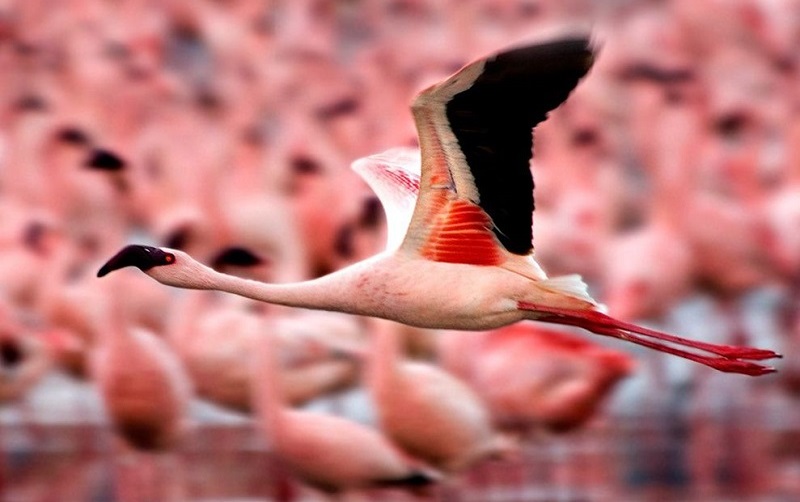
Habit
Groups of flamingos are called flocks. They work together to protect each other from predators and take care of their young.
It is believed that flamingos are a “monogamy” couple. Once mated, they will stay with that mate. A group of it will mate simultaneously so that all the chicks will hatch at the same time. Pairs will nest in the mud, and the females will lay one egg at a time.
Eggs are slightly larger than chicken eggs, 78 to 90 mm long and 115 to 140 grams. The eggs will take 27 to 31 days to hatch, and the newly hatched chicks will weigh only 73 to 90 g.
Baby flamingos are gray or white. They will turn pink in the first few years of life. This bird can live 20 to 30 years in the wild or 50 years in a zoo.
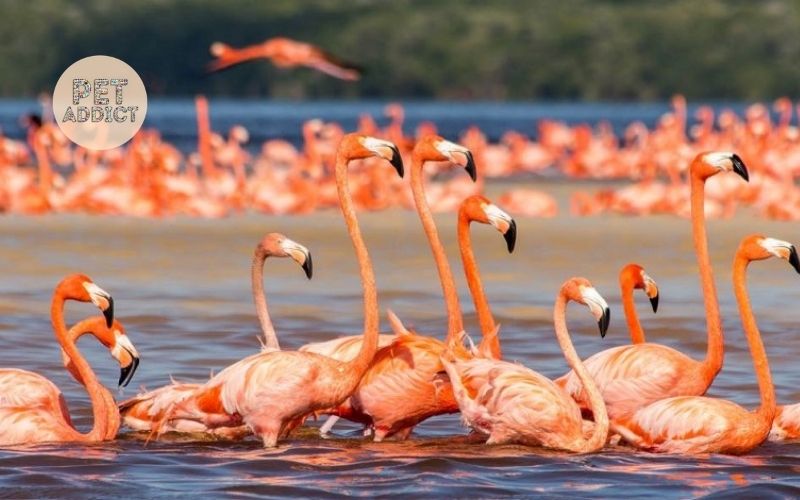
You may also like: What is Indian Peacock? Interesting Facts About It
What do Flamingos Eat?
It eats larvae, small insects, green and red algae, mollusks, crustaceans, and small fish. Their ability to eat both plants and meat makes them omnivores.
It is pink because the algae they eat are loaded with beta carotene, an organic chemical that contains a red-orange pigment. (Beta carotene is also present in many plants, but especially in tomatoes, spinach, pumpkins, sweet potatoes, and of course, carrots.) The krill and crustaceans eaten by flamingos contain similar carotenoids.
The level of carotenes (organic pigments) in their food varies in different parts of the world, which is why American flamingos are usually bright red and orange. In contrast, It is usually bright red and orange. The flamingos of the drought-stricken Lake Nakuru in central Kenya are paler pink.
If a flamingo stops eating food containing carotenoids, its new feathers will begin to grow in a much lighter color, and its red feathers will eventually fall off. New feathers lose their light pink color.
What a flamingo eats depends on the type of beak it has. The James and Andean flamingos have what is called a short break, which feeds mainly on algae. Chilean and American flamingos have shorter beaks, allowing them to eat insects, invertebrates, and small fish.
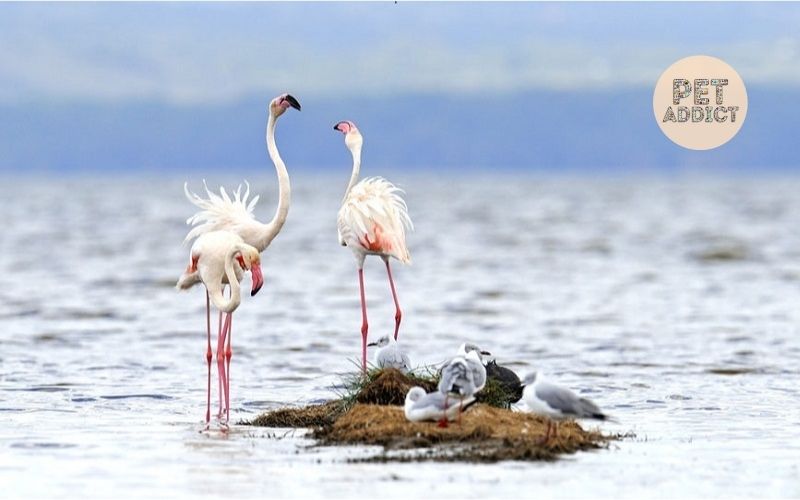
Some Interesting Facts about Flamingos
- Their fur is white and gray when young and gradually changes color as they grow and receive food.
- They have a strange beak structure, so flamingos eat backward.
- It spend 15%-30% of the day cleaning their feathers.
- Male birds also have milk, called “kite milk.”
- It usually stand on one leg. This helps them save energy, keeping body heat.
- In the wild, the life span of a flamingo is from 20 to 30 years old. The record for the oldest flamingo on record is 70 years old.
- They only lay one egg at a time.
- It have black wing feathers underneath, only visible when they fly.
- Sometimes, they even steal each other’s nests.
- It can detect rain 500km away. Its weather sense remains a mystery to this day.
- The word Flamingo comes from the Spanish and Latin word ‘flamenco’ which mean fire, it refers to the bright colours of the bird’s feathers
- It is powerful fliers, when flying in a flock, the top speed of a flamingo can be as high as 35 miles per hour
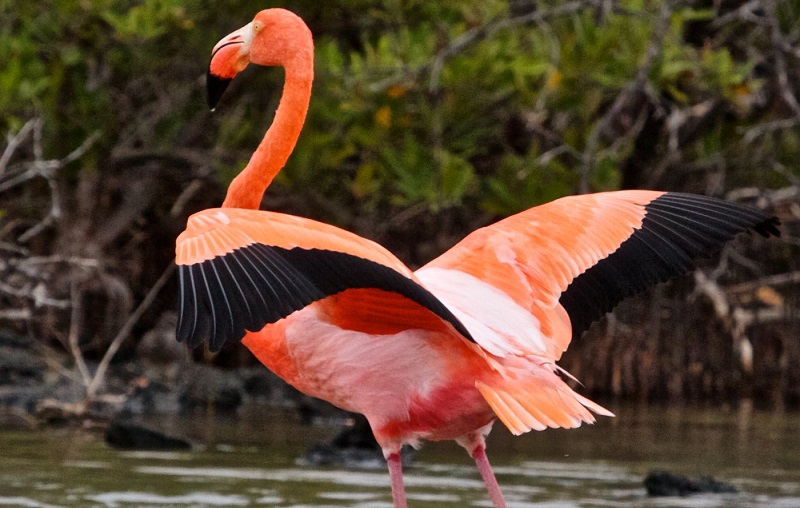
Frequently Asked Questions (FAQs)
Why are Flamingos Pink? Actually, flamingos are not pink. They are born with grey feathers, which gradually turn pink in the wild because of a natural pink dye called canthaxanthin that they obtain from their diet of brine shrimp and blue-green algae.
Why Do Flamingos Stand on One Leg? Flamingos may be doing their one-legged tree pose to stay warm or just because it’s comfortable.
How long do Flamingos live? It tends to live a long life in the wild though with an average of 25 to 30 years. In captivity, some of them have lived up to 40 years.
Read more: Bird
Conclusion
Flamingos are interesting birds, aren’t they? Hopefully through the above article can help you have an overview and know before buying it. Follow Petaddict.net to know more about animals.

